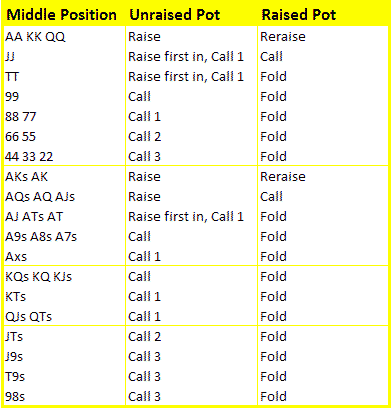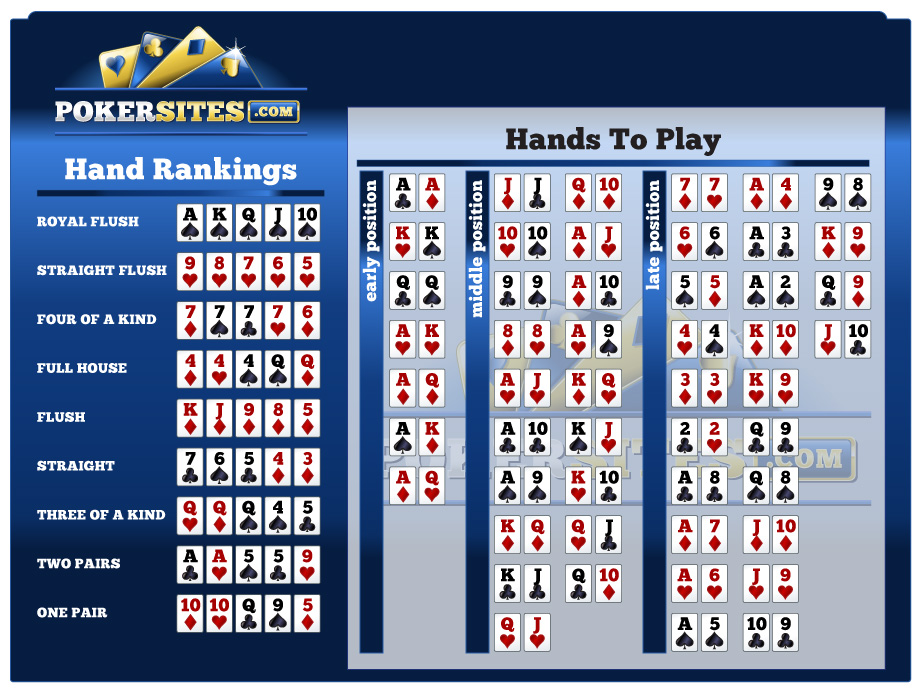Odds Of Poker Hands Texas Holdem
- Odds Of Texas Holdem Hands
- Odds Of Poker Hands Texas Holdem Play
- Odds Of Poker Hands Texas Holdem Card Game
- Odds Of Poker Hands Texas Holdem Rules
Whereas in regular hold'em there are 1,326 distinct starting hands, in short deck hold'em there are only 630 distinct starting hands — less than half (about 47.5 percent). That's counting suits.
- Texas Holdem Heads-Up Preflop Odds. This table was created by enumerating through every possible board and opponent hole card combination for each of the 169 texas holdem preflop starting hands. The numbers are exact to the rounding I used, which was.
- If you ever wanted to know some of the odds and probabilities of Texas hold'em poker, from the chances of flopping a flush (0.8%) or set (12%) to the odds of an overcard coming on the flop when.
The table below shows the odds of each hand winning in typical all-in match ups in Texas Holdem. The percentage chance of winning assumes that both players are all-in and that all 5 community cards will be dealt to determine a winner. The table also assumes that there are no other players in the hand, although the results should be very similar.
All-in hands probability odds chart.
| Typical Match Up | Hand 1 | Hand 2 | ||
|---|---|---|---|---|
| Under Pair vs. Overcards | T T | 57% | 43% | A K |
| Overpair vs. Pair | K K | 80% | 20% | 9 9 |
| 2 Overcards vs. 2 Undercards | A Q | 63% | 37% | 5 7 |
| Dominated Hand | A J | 79% | 21% | J T |
| Very Dominated Hand | Q Q | 89% | 11% | Q J |
| Overcard vs. Dominated Kicker | A 9 | 29% | 71% | 9 9 |
| Pair vs. 1 Overcard | 8 8 | 69% | 31% | A 5 |
| 1 Overcard vs. 2 Middle Cards | J 4 | 57% | 43% | 6 8 |
How to use the all in match-ups odds chart.
The table can be used to estimate your chances of winning in common all-in situations, however, the table does not highlight the exact probabilities for the certain match-ups in general.
For example: in the pair v overcards match-up, 2 2 would be a 53% favorite against A K instead of being a slightly stronger favorite like T T with a 57% chance of winning. The is due to other factors such as the increased probability that two overpairs will appear on the board creating a higher two-pair with a better kicker for the player holding A K.
All in match up odds evaluation.
As you can see from the table, some of the match-ups are closer than you might expect them to be. For example, if you have another player dominated with a hand like A J against J T, your opponent will win the pot 1 time in 4. Therefore you should be careful not to become overly excited when cards like these are turned over in an all-in situation, because your opponent is not always as far behind as you think.
Another interesting all-in match up is the very common AK versus an under pair. The table shows that although the odds are fairly even, the under-pair will usually have the slight advantage.
This means that it is always better to be pushing all-in rather than calling an all-in with AK if necessary, because to call with AK against an under pair is a losing play in the long run. By pushing all-in with AK you give your opponent the opportunity to fold for fear of an overpair, which will improve your expectation in the long run.
Go back to the poker odds charts.
Can You Afford Not To Use
Poker Tracker 4?
Odds Of Texas Holdem Hands
“I wouldn’t play another session of online poker without it”
“I play $25NL, and in under 1 week PT4 had paid for itself”
Comments
In this lesson we’re going to run through a number of heads-up match-ups that will help give you an idea of where you stand in a variety of pre-flop situations when playing hold’em. Be aware that we’re only going to focus on individual hand match-ups. When playing hold’em it’s essential that you put your opponent on a range of hands, rather than specific holdings. However, knowing the odds of common pre-flop match-ups is a good starting point. Pick out and study what will help you. While it’s not essential that these statistics be committed to memory, it won’t hurt you if you do.
Let’s start by looking at hand match-ups when holding a pair:
Pair vs. Pair
The higher pair is an 80 percent favourite. We can get very technical and highlight the fact that if the underpair didn’t have any clean suits and/or the maximum number of straight outs then the high pair’s equity would increases by one or two percent.

Pair vs. Overcards

This is the classic coin flip hand that you’ll see many times late in tournaments with one player being all-in. The term coin flip indicates an even money situation which is really a 55 to 45 percent situation, as the pair is a slight favourite.
Pair vs. Undercards
In this situation the pair is normally about a 5-to-1 favourite and can vary depending on whether the two undercards are suited and/or connectors.
Pair vs. Overcard and an undercard
The pair is about a 70 percent favourite. Another example of this holding would be J-J against A-9. The underdog non-paired hand has three outs while the favourite has redraws.
:max_bytes(150000):strip_icc()/78432412-56a741f15f9b58b7d0e84d3a.jpg)
Pair vs. Overcard and one of that pair
Odds Of Poker Hands Texas Holdem Play
The classic example of this situation is the confrontation between a pair of cowboys and big slick. The A-K has three outs and it becomes a 70-30 percent situation or a 2.3-to-1 dog for the cowboys. This is a far cry from the next situation where even though one of the pair is matched the other card is lower.
Pair vs. Undercard and one of that pair
The non pair has to hit its undercard twice or make a straight or flush to prevail. The pair is better than a 90 percent favourite or slightly better than 10-to-1 odds. I’ll take those odds anytime.

Pair vs. Lower suited connectors
You see this match-up late in tournaments when a player is getting desperate and pushes all-in with middle suited connectors. A hand such as Q-Q against 7-6 suited would be a prime example. The pair is a strong favourite to win.
Pair vs. Higher suited connectors
Here is the real coin flip situation. A pair of eights heads-up against a suited Q-J is a fifty-fifty proposition. The higher suited cards would have an edge against a lower pair, such as 2’s or 3’s, since the board itself can sometimes destroy little pairs.
Common Pre-Flop Match-Ups (Non Pairs)
The following heads-up confrontations contain no pairs.
Two high cards vs. Two undercards
The two higher cards are usually a 65% favourite to win, but it can vary depending on whether any of the cards are suited and/or connectors.
High card, low card vs. Two middle cards
In this match-up the high card gives it the edge. But it’s only a marginal winner, approximately 57% to the hand containing the high card.
High card, middle card vs. Second highest, low card
The edge is increased by around 5% when the low card becomes the third highest card, as shown in this example, which gives approx 62% to 38% for high card/middle card combination.
High card, same card vs. Same card, low card
In this example the A-J is in a very strong position. If we discount any flush or straight possibilities, it only leaves the player holding J-8 with three outs (the three remaining 8’s).
Same high card, high kicker vs. Same card, low kicker
The high kicker gives this hand a fairly big edge. It’s very common for A-K run into A-Q, A-J, and lower, and it’s why Ace-King is such a powerful hand, particularly at the business end of no-limit hold’em tournaments when people move all-in with any sort of Ace.
Statistical Variations
For any math maniacs reading this who do not find these odds precise enough, I acknowledge that the math is rounded and for the most part does not take into account the possibilities of ties and back door straights and flushes. What players need to be equipped with is the general statistical match-up – not the fact that in the example of a pair of eights against a suited Q-J the percents are exactly 50.61 for the eights to 48.99 for the suited connectors with the balance going to potential ties. I call that a fifty-fifty proposition.
Of greater importance than quibbling over tenths of a percent is the fact that in most heads-up confrontations you can never be a prohibitive underdog. That is one reason why poker is so challenging and fun. Of course, while true, I’m not attempting to embolden the reader to ignore the odds and become a maniac. Math is the underpinning of poker and if you regularly get your money into the middle with the worst of it you will go broke.
One statistic that hasn’t been mentioned, and it’s one that I particularly like is this – the odds of both players being dealt Aces when playing heads up (one on one) is 270,724-to-1. It’s my favourite statistic because it provides me with almost total confidence when I’m playing heads up and receive pocket Aces that I’m the boss! That confident feeling lasts right up to the river when my Aces get cracked by some rotten piece of cheese which my opponent elected to play. As mentioned already, rarely are you a prohibitive underdog – so remember that to keep those losing hands in perspective.
Related Lessons
By Tom 'TIME' Leonard
Odds Of Poker Hands Texas Holdem Card Game
Tom has been writing about poker since 1994 and has played across the USA for over 40 years, playing every game in almost every card room in Atlantic City, California and Las Vegas.